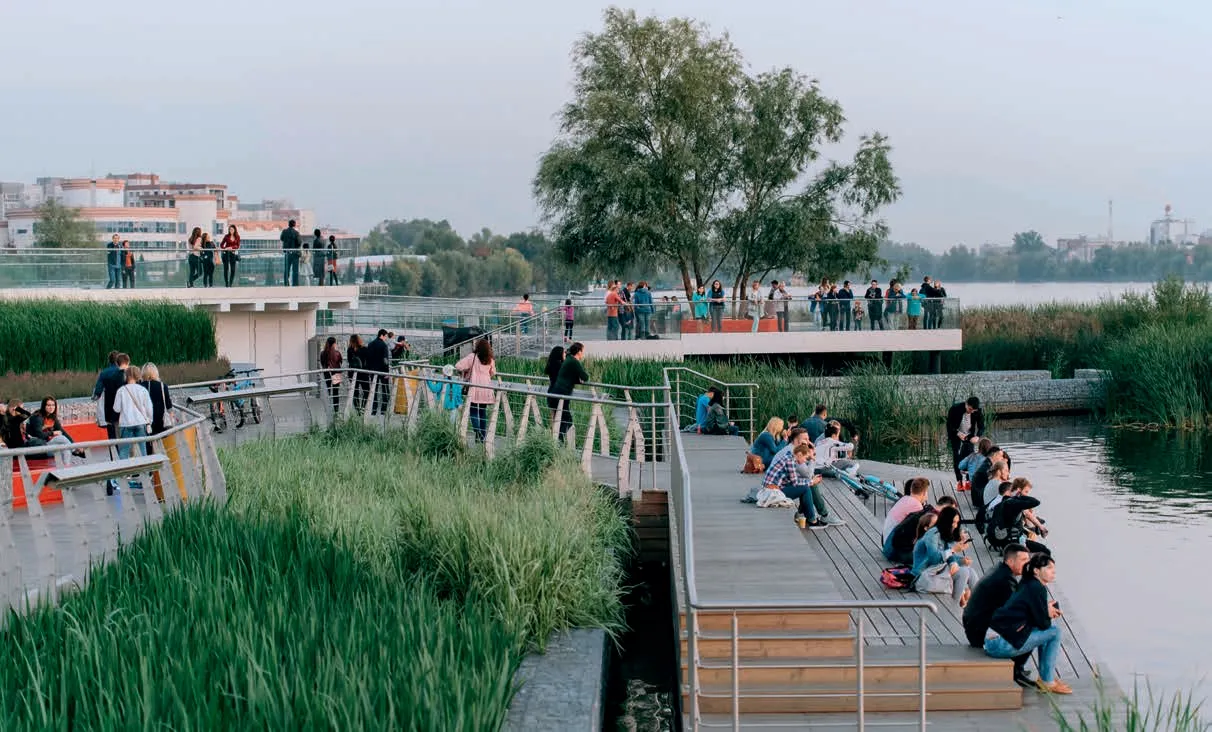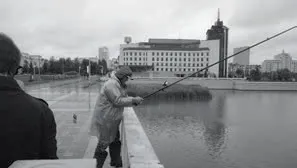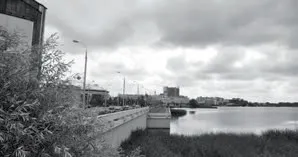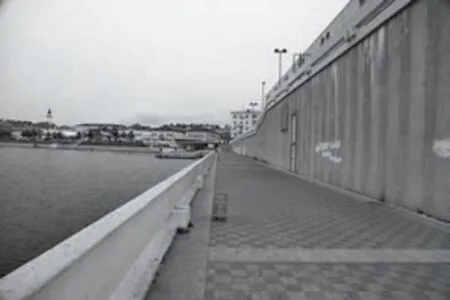喀山市卡班湖群滨水区的复兴,喀山,俄罗斯
2020-02-08尚晋
(尚晋 译)

1 生态海绵设施与文教设计相结合。现有的树木(如图 中的柳树)受到良好的保护,并被整合在新设计中/The biological infiltration facilities are integrated with recreational and educational design. The preexisting trees (in this picture, a willow tree) are well protected and integrated in the new design
项目概况
喀山市卡班湖被废弃的滨水区通过谨慎的景观改造干预,在很短的时间内实现了复兴。该项目将景观呈现为一种互动性的载体。该项目将景观作为一个调节水文环境、提升区域可达性、提升公众交往机会的互动载体,可以为公共空间与自然、文化、社会发展产生联系提供诸多机会。
挑战与目标
喀山是鞑靼斯坦共和国的首府,人口120 万,为俄罗斯第六大城市。下卡班湖北侧与东侧的岸线构成了城市的滨水空间。项目面积约为30hm2,涵盖了长达约2km的岸线范围。伴随着长达700年的生活垃圾与工业废水的排放,被污染的湖体与城市严重割裂,致使城市失去了重要的活力来源与生态基础设施。虽然湖畔的各类工业在过去几十年中相继破产,城市径流仍在污染湖水;历史中心区部分的湖体周边粗暴地建起了水泥护堤,将城市最重要的的滨水区变成了一片死气沉沉的混凝土沙漠;由于高速公路、私人社区、废弃工业用地与杂草丛生的树林的阻断,卡班湖的绝大部分滨水空间对于公众来说是无法靠近的。卡班湖现有的开发区是围绕着机动车的通行需求规划的,这不仅割裂了野生动物栖息地,并且阻碍了人们抵达滨水区域。借着举办2018 FIFA世界杯的契机,鞑靼斯坦政府决定改造这个城市最为重要的滨水区。
设计策略
在赢得国际竞赛后,景观设计师被委托设计卡班湖滨水区复兴项目。在应对上述挑战时,他提出了喀山卡班湖群滨水区活力复兴的三大改造策略:
(1)让滨水区畅行安全:粗野的混凝土防洪墙和沿岸的交通道路割裂了城市与水体之间的关系。为解决这一问题,在混凝土护堤以外的水域建造了一系列平台和栈道;坡道与台阶连接了漂浮着的的步行栈道、活动场地与河岸上的人行道。沿岸修建了慢行通道。步行道和平台旁还提供了大量座椅。
(2)沿湖岸设立水体修复缓冲区:利用台地状的湿地与生态净化池吸纳周边小型水渠的排水与雨水形成的地表径流。这些生态海绵设施亦可同时提供休闲功能与公共教育功能。
(3)精心策划活动:通过与文化部和当地社区合作,策划了多种多样的文化体育活动,如夏夜音乐会和电影、清晨瑜伽,以及白天的环境教育旅行。
结语
该项目历时一年完工,取得了巨大的成功。在2018年5月面向公众开放的第一个月,这个曾被废弃的滨水区就迎来了5万人的日流量。不同信仰、年龄和性别的人都能在这个滨水区找到自己的一席之地。音乐会、电影、运动、瑜伽、婚礼,甚至仅是美好怡人的阳光,都会让他们聚集在此。清理一新、郁郁葱葱的滨水区还引来了更多的候鸟和留鸟。在与城市居民生活割裂、长达百年的孤寂之后,这个喀山市曾被忽视的滨水区域如今已重获生机。健康的生态环境、充满活力的文化氛围极好的提升了周边居民归属感、增强了国民尊严与身份认知。□
多年来,从副院长到院长,张伟一直关注医院用药安全。“药物一直是把双刃剑,用得好是患者福音;用不好,将为患者制造负担,甚至从公益角度来看,会造成社会和环境污染。”为此,近年来,南大一附院形成了“四个一”规章:两周一检、两周一议、两周一评、两周一罚。“用药安全,是患者健康保障的最重要关口,也是医院进行精准诊断和精准治疗的最重要‘守门人’。”
(尚晋 译)
Project statement
Through prudent transformative landscape interventions, the deserted prime waterfront of Kazan City at Kaban Lake has been revitalised in a short time span. The project showcases landscape as an interactive medium that regulates hydrological environment, creates public access and provides numerous opportunities to connect new public realms which can function as a common denominator of nature, culture, and social developments.
Challenges and objectives
Kazan is the capital of the Republic of Tatarstan, and is the sixth most populous city in Russia, with a population of 1.2 million. The city's prime waterfront is the north and east shoreline of Lower Kaban Lake. The project covers a shoreline of 2.0 kilometre and an area of about 30hm2. After 700 years of dumping domestic and industrial waste in Kaban Lake, the city was separated from its waterfront, resulting in the loss of an important source of cultural vitality and ecological amenities. While the industries surrounding the lake were bankrupted in past decades, the urban runoffs are still polluting the lake; brutal concrete embankments were built into the water in the historic downtown section turning the city's prime waterfront into a lifeless concrete desert; other parts of Kaban Lake were mostly inaccessible to the public due to high-speed roadways, private communities, and overgrown groves on abandoned brownfield. The existing development area of Kaban Lake was planned around the automobile, which not only fragmented wildlife habitats, but also prevented people from reaching the waterfront. Utilising the development opportunity presented by hosting the 2018 FIFA World Cup, the Tatarstan government decided to reclaim this prime waterfront.
Design strategies
After winning the international competition, the landscape architect was commissioned to design the Kaban Lake waterfront revitalisation project. In addressing the above challenges, he proposed three major transformative strategies to reclaim the vitality of Kazan's prime waterfront:
(1) Making the waterfront accessible and safe: the brutal concrete flood wall and the traffic road along the shoreline severed the relationship between the city and the water. To solve this problem, a series of platforms and boardwalks built into the water beyond the concrete embankment; ramps and stairs link these pedestrian paths and places that float above the lake with the pedestrian paths on the land. Bicycle and pedestrian trails were constructed along the lake shore. Numerous seats are provided along the pedestrian paths and the platforms.
(2) Creating a water remediation buffer zone along the lake shore: terraced wetland and bio swales are designed to catch the flows from several small ditches and the surface urban runoff. These biological infiltration facilities are integrated with recreational design and public education.
(3) Programmed activities: Working with the Ministry of Culture and local communities, various cultural and sports activities are programmed, such as music concerts and movies on summer nights, yoga in the morning, and environmental education tours in daytime.
Conclusion
The project was completed in one year and has proven to be a great success. The first month it was open to the public in May of 2018, the formerly deserted waterfront attracted 50,000 users daily. People of different beliefs, ages, and genders find their place at the waterfront. They gather here for concerts, movies, exercising, yoga, weddings, or simply people watching and enjoying the sun. The cleansed and vegetated lakefront also attracts more migrant and resident birds. After over century's alienation from the city and its people, Kazan's neglected prime waterfront has now been reclaimed with ecological health, cultural vitality, and the residents' feeling of belonging, as well as the dignity and the identity of the state.□

2 总平面/Site plan
项目信息/Credits and Data
客户/Client: 鞑靼斯坦共和国政府/Government of the Republic of Tatarstan
景观与建筑施工设计公司/Landscape Architect of Record/Firm: 土人设计/Turenscape
设计负责人/Design Lead: 俞孔坚/YU Kongjian
项目总监兼高级架构师/Programme Director and Senior Architect: Stanley LUNG
高级城市规划师/Senior Urban Planner: YAN Bin
高级景观设计师/Senior Landscape Architect: SHI Chun
项目经理兼城市规划师/Program Manager and Urban Planner: WANG Yuyu
项目经理兼景观设计师/Program Manager and Landscape Architect: CONG Xin
城市规划师/Urban Planner: MA Junge, KOU Miao, WU Di景观设计师/Landscape Architect: HU Yangyang, JING Bo, SONG Qiuyue, LUO Lin, DING Yahu, LIU Zhenlizi, YUAN Tingting, ZHANG Haixiao, ZHANG Jin
地理信息系统分析师/GIS Analyst: LI Wenhao
高级建筑师/Senior Architect: Alexandr Poroshkin, Katya Sineva, Max Malein
助理景观设计师/Assistant Landscape Architect: Henry Herman, ZHANG Kaiqi, XIE Yaoyu, Nichlas Rasmussen
俄罗斯建筑合作者/Russian Architecture Collaborator: MAP architects Design Office
照明设计/Lighting: ECO-Light

3 平台建造在混凝土墙外的水中/Platforms is built into the water beyond the concrete wall




4 不近人情的混凝土防洪墙切断了城市与水的联系。为了 解决这个问题,湖中建造了抗洪平台,以激活混凝土 堤岸以外死气沉沉的区域/The brutal concrete flood walls cut off the relationship between the city and the water. To solve this problem, flood resilient platforms are built into the lake to activate the dead space beyond the concrete embankment




5 一片死气沉沉的空间获得了生机:昔日荒芜的滨水区已 成功重新启用,并在2018年夏季对外开放时每天吸引5万 游客/A dead space has gain its life: The former deserted water front has been successfully reactivated and has attracted 50,000 visitors daily in the summer of 2018 when it is opened to the public




6 与当地的文化部和社区合作,这里安排了各种文化和 体育活动,如夏季晚上的音乐会和电影、早晨的瑜伽和 白天的环境教育旅行/Working with the Ministry of Culture and local communities, various cultural and sports activities are programmed, such as music concert and movies in the summer nights, Yoga in the morning, and environmental education tours on the day

7 安排现有的地形,这里提供了许多座位,并仔细整合、 分级,使滨水段既安全又舒适,面向所有年龄段的使用者/ Making the preexisting terrain, a lot of seats are provided and carefully integrated into the grading to make the waterfront both safe and restful for users of all ages
评论
张利:我们可以想象两种优异的设计,它们同样令人赞叹:一种是拍案称奇的设计干预想象力,我们一般称之为“设计实验”;另一种是深入人心的生活质量提升,我们一般称之为“社会实践”。卡班湖的设计属于后者。
虽然以景观的设计策略来大幅度提升被基础设施分割的线性滨水空间质量不是什么新鲜事,但能够在发展中经济体的环境下以非常有限的造价来完成如此令人信服的改进仍然是罕见的。设计者的匠心体现在两个方面:一是尽量采用原生态或准原生态的种植体系,这使得在可控的建设与维护成本下实现巨大尺度的干预成为可能;二是在局部近人尺度上对微差界面(坡道、台阶、波浪形地面等)的使用,这使得在重要空间节点上形成人员聚集的公共性成为可能。从某种意义上说,卡班湖的实践是非常贴近IUPA设立的初衷的。
叶扬:作为中国设计团队在海外的实践,卡班湖群滨水区的设计国际化、普世化,用相对简洁的方式改变了城市的工业废地,将原有生硬、冷漠的滨水区域进行了柔化处理,水边植物与木材等具有温暖质感的材料搭配增加亲和力,不同类型的活动区域既独立又连贯,动线悠长、蜿蜒,层层叠落,逐步亲水,视觉上始终保持开放、通透。该项目出色地用设计的方式使市民获得了一块具有公共性、充满活力的城市空间,为解决此类典型的城市问题区域提供了一个范例。

8 生态海绵梯田与文教设计融为一体,昼夜不断地吸引着 来人/The biological infiltration terraces are integrated with recreational and educational design and becomes a attraction day and night
Comments
ZHANG Li: There are two types of design excellence, equally desirable: one that built on imaginative design intervention which is usually referred to as design experiment, and one that built on tangible improvement of real life which is usually referred to as social intervention. The Kaban lake project belongs to the latter. Although it is not new to revitalise the linear waterfront space cut, polluted and deteriorated by modern transportation infrastructure, bringing such convincing change to real life is still rare. There are two design strategies that are demonstrably useful: the first is the plant system primarily based upon natural choice, which significantly reduces the initial cost and the cost for long term maintenance; the second is the use of human scale, fine-grained urban fabric (ramps, steps and undulating surfaces) in special segments of the project, creating popular nodes of public activities along the linearity of the entire project. In a sense, the Kaban Lake Waterfront Revitalisation project is very pertinent to the original intention of IUPA.
YE Yang: As an oversea practice of Chinese design team, the design of Kaban Lake's prime waterfront tends to be international and universal. The deserted industrial landscape of the city was reformed by relatively simple approach. The existing curt indifferent waterfront was softened by water plants and the materials with warm sense such as timber which increased affinity. Various types of activity zones are both independent and coherent, with extended and winding circulation, directing people to the shore step by step, meanwhile, keeping the view open and transparent. The project is excellently designed to provide citizens with a public urban space that full of energy, offering an exemplar for such a typical urban wasted area. (Translated by PANG Lingbo)
